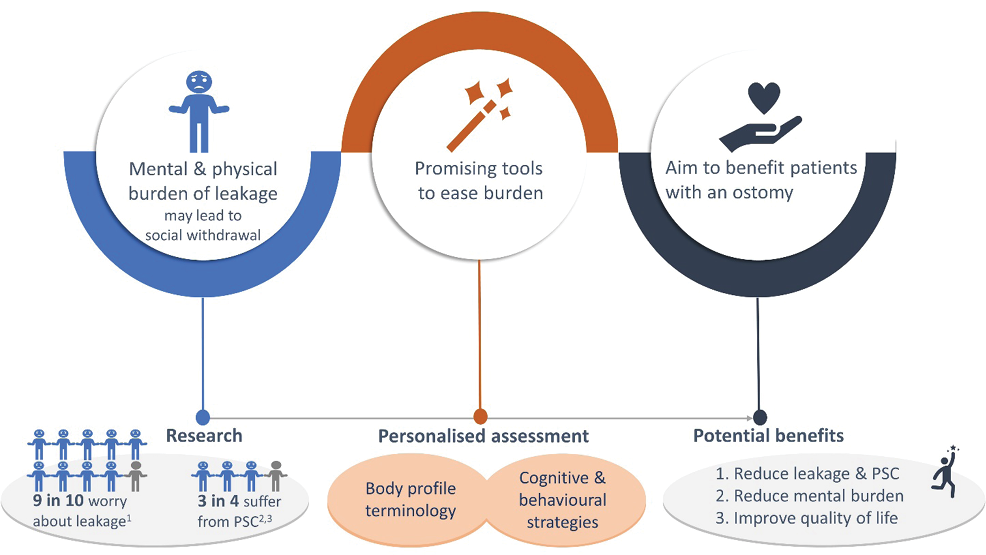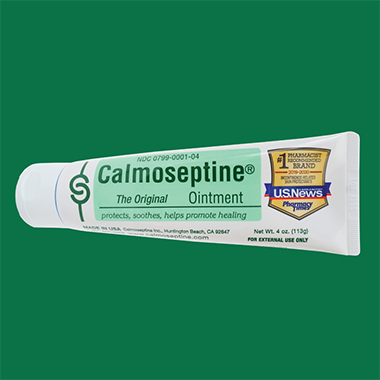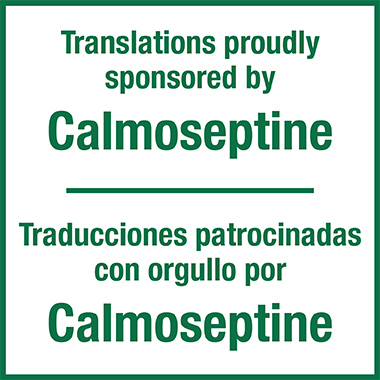Volume 42 Number 2
Editorial
Iben Plate
For referencing Plate I. Editorial. WCET® Journal Supplement 2022;42(1)Sup:s3-4
DOI https://doi.org/10.33235/wcet.42.1.sup.s3-4
The presence and persistence of stoma-related complications following ostomy surgery constitute a major burden for individuals living with an ostomy, a burden comprising physical as well as mental components. The physical component includes leakage of stomal effluent and peristomal skin complications, which may range from mild peristomal dermatitis to full thickness painful skin ulcerations1,2. Additionally, the profound bodily changes following surgery, along with the risk and worry of leakage and complications, may lead to psychosocial problems, including depression, anxiety, low self-esteem and social withdrawal3. These may adversely affect the individual’s adaptation to the stoma and quality of life. Therefore, critical components of ostomy care comprise prevention and management of leakage and skin complications, while helping patients adjust to their changed body and re-engage with their social environment (Figure 1). An insight into these issues is provided in two articles included in the following pages of this WCET supplement.

Figure 1. An overview of the problem of peristomal leakage and skin complications faced by individuals living with an ostomy, and approaches to help mitigate these problems
PSC = peristomal skin complication
1. Claessens I, Probert R, Tielemans C, et al. The Ostomy Life Study: the everyday challenges faced by people living with a stoma in a snapshot. Gastrointest Nurs 2015;13(5):18–25.
2. Salvadalena G, Colwell JC, Skountrianos G, et al. Lessons learned about peristomal skin complications: secondary analysis of the ADVOCATE trial. J Wound Ostomy Continence Nurs 2020;47(4):357–63.
3. Herlufsen P, Olsen AG, Carlsen B, et al. Study of peristomal skin disorders in patients with permanent stomas. Br J Nurs 2006;15(16):854–62.
In the first article, author Janice Colwell argues that one of the most important contributions ostomy care specialists can make to their patients is to help them find the best pouching system in terms of the right size of the skin barrier opening and the best shape (flat or convex) of the skin barrier. While the size of the barrier opening depends on the size of the stoma, the shape of the barrier should be based on a thorough assessment of the patient’s peristomal body profile, the stoma, and the output volume and consistency. The author recommends using a convex solution, particularly if the peristomal area is soft, if there are skin creases/folds, or if the stoma lumen is at or below the skin level4. The importance of reassessing patients on an ongoing basis is emphasised to ensure continued use of the optimal pouching system.
The second article by Anne Steen Hansen and colleagues further discusses the importance of a good fit of the ostomy product to reduce leakage and skin complications. It alludes to a modified Delphi consensus building process involving over 1200 stoma care nurses from 27 countries; this helped to create practical guidelines on how to accurately assess body and stoma profiles. The process was facilitated by Coloplast. The standardised Body Profile Terminology5,6 was recommended for characterising the peristomal body profile of patients. Further highlighted in the second article are results from a scoping review undertaken by a group of ostomy care nurses and physicians; these results indicate that convexity should be considered at all times after ostomy surgery, including in the immediate postoperative period, to secure pouch seal and prevent leakage4.
Overall, the articles emphasise the importance of tailoring ostomy care to include individual preferences and peristomal body profiles to obtain the optimal ostomy solution to prevent leakage and skin complications. By implementing such individualised approaches, ostomy care professionals can considerably improve the lives of the millions of individuals around the world living with an ostomy.
This supplement has been supported by

June 2022
La presencia y la persistencia de complicaciones relacionadas con el estoma después de la cirugía de ostomía constituyen una carga importante para las personas que viven con una ostomía, una carga que comprende componentes físicos y mentales. El componente físico incluye la fuga de efluentes estomales y las complicaciones de la piel periestomal, que pueden ir desde una dermatitis periestomal leve hasta ulceraciones cutáneas dolorosas de espesor total1,2. Además, los profundos cambios corporales que se producen tras la cirugía, junto con el riesgo y la preocupación por las fugas y las complicaciones, pueden provocar problemas psicosociales, como depresión, ansiedad, baja autoestima y aislamiento social3. Esto puede afectar negativamente a la adaptación del individuo al estoma y a su calidad de vida. Por lo tanto, los componentes críticos del cuidado de ostomía comprenden la prevención y el manejo de las fugas y de las complicaciones de la piel, a la vez que se ayuda a los pacientes a adaptarse a los cambios de su cuerpo y a volver a participar en su entorno social (Figura 1). Dos artículos incluidos en las siguientes páginas de este suplemento del WCET ofrecen una visión de estas cuestiones.

Figura 1. Una visión general del problema de las fugas periestomales y de las complicaciones cutáneas a las que se enfrentan las personas que viven con una ostomía, y los enfoques para ayudar a mitigar estos problemas
PSC = complicación cutánea periestomal
1. Claessens I, Probert R, Tielemans C, et al. The Ostomy Life Study: the everyday challenges faced by people living with a stoma in a snapshot. Gastrointest Nurs 2015;13(5):18–25.
2. Salvadalena G, Colwell JC, Skountrianos G, et al. Lessons learned about peristomal skin complications: secondary analysis of the ADVOCATE trial. J Wound Ostomy Continence Nurs 2020;47(4):357–63.
3. Herlufsen P, Olsen AG, Carlsen B, et al. Study of peristomal skin disorders in patients with permanent stomas. Br J Nurs 2006;15(16):854–62.
En el primer artículo, la autora Janice Colwell sostiene que una de las contribuciones más importantes que los especialistas en cuidados de ostomía pueden hacer a sus pacientes es ayudarles a encontrar el mejor sistema de bolsa en cuanto al tamaño adecuado de la abertura de la barrera cutánea y la mejor forma (plana o convexa) de la misma. Aunque el tamaño de la abertura de la barrera depende del tamaño del estoma, la forma de la barrera debe basarse en una evaluación exhaustiva del perfil del cuerpo periestomal del paciente, del estoma y del volumen y la consistencia de la salida. El autor recomienda utilizar una solución convexa, sobre todo si la zona periestomal es blanda, si hay pliegues o dobleces en la piel o si el lumen del estoma está a nivel de la piel o por debajo de ella4. Se subraya la importancia de reevaluar a los pacientes de forma continuada para garantizar el uso continuado del sistema de bolsa óptimo.
El segundo artículo, escrito por Anne Steen Hansen y sus colegas, analiza además la importancia de un buen ajuste del producto de ostomía para reducir las fugas y las complicaciones cutáneas. Alude a un proceso de creación de consenso Delphi modificado en el que participaron más de 1.200 enfermeros especializados en el cuidado de estomas de 27 países; esto ayudó a crear directrices prácticas sobre cómo evaluar con precisión los perfiles del cuerpo y del estoma. El proceso fue facilitado por Coloplast. Se recomendó la terminología estandarizada del perfil del cuerpo5,6 para caracterizar el perfil del cuerpo periestomal de los pacientes. En el segundo artículo se destacan además los resultados de una revisión de alcance realizada por un grupo de enfermeros y médicos de cuidados de ostomía; estos resultados indican que la convexidad debe considerarse en todo momento después de la cirugía de ostomía, incluso en el período postoperatorio inmediato, para asegurar el sellado de la bolsa y prevenir las fugas4.
En general, los artículos hacen hincapié en la importancia de adaptar los cuidados de ostomía para incluir las preferencias individuales y los perfiles del cuerpo periestomal para obtener la solución de ostomía óptima para prevenir las fugas y las complicaciones cutáneas. Al aplicar estos enfoques individualizados, los profesionales en cuidados de ostomía pueden mejorar considerablemente la vida de los millones de personas que viven con una ostomía en todo el mundo.

Author(s)
Iben Plate
Director of Evidence & Adoption, Coloplast A/S
References
- Meisner S, Lehur PA, Moran B et al. Peristomal skin complications are common, expensive, and difficult to manage: a population based cost modeling study. PloS One 2012;7(5):e37813.
- Kwiatt M, Kawata M. Avoidance and management of stomal complications. Clin Colon Rectal Surg 2013;26(2):112–21.
- Ayaz-Alkaya S. Overview of psychosocial problems in individuals with stoma: a review of literature. Int Wound J 2019;16(1):243–9.
- Colwell JC, Davis JS, Emodi K, et al. Use of a convex pouching system in the post-operative period – a national consensus. In press. 2022.
- Global Coloplast Ostomy Forum. Ostomy life study review 2016/17. Coloplast A/S;2017:1–23. Available at: https://www.coloplast.com/Documents/Stoma/CP_MM_OstomyLifeStudy_2016.pdf.
- Colwell JC, Bain KA, Hansen AS et al. International consensus results: development of practice guidelines for assessment of peristomal body and stoma profiles, patient engagement, and patient follow-up. J Wound Ostomy Continence Nurs 2019;46(6):497–504.



